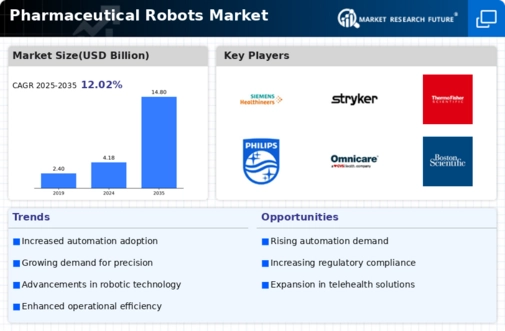Rising Demand for Efficiency
The Pharmaceutical Robots Market experiences a notable surge in demand for efficiency within pharmaceutical manufacturing processes. Automation through robotics enhances productivity, reduces human error, and streamlines operations. As pharmaceutical companies strive to meet increasing production demands, the integration of robots becomes essential. According to recent data, the market for pharmaceutical robots is projected to grow at a compound annual growth rate of approximately 12% over the next five years. This growth is driven by the need for faster drug production cycles and the ability to maintain high-quality standards. Consequently, the Pharmaceutical Robots Market is likely to witness a significant transformation as companies adopt advanced robotic solutions to optimize their manufacturing capabilities.
Advancements in Robotics Technology
Technological advancements play a pivotal role in shaping the Pharmaceutical Robots Market. Innovations in artificial intelligence, machine learning, and robotics are enabling the development of more sophisticated and versatile robotic systems. These advancements allow robots to perform complex tasks such as precise drug dispensing, packaging, and quality control with greater accuracy. The integration of AI-driven analytics further enhances operational efficiency by providing real-time data insights. As a result, pharmaceutical companies are increasingly investing in these technologies to remain competitive. The Pharmaceutical Robots Market is expected to benefit from these advancements, as they facilitate the creation of smarter, more adaptable robotic solutions that can meet the evolving needs of the industry.
Growing Focus on Personalized Medicine
The shift towards personalized medicine is reshaping the Pharmaceutical Robots Market. As healthcare providers increasingly tailor treatments to individual patient needs, the demand for customized drug formulations rises. Robotics technology facilitates the efficient production of personalized medications by enabling precise dosage and formulation adjustments. This capability is particularly crucial in the context of complex therapies that require individualized approaches. The Pharmaceutical Robots Market is poised to expand as companies adopt robotic systems that can accommodate the intricacies of personalized medicine. This trend reflects a broader movement towards patient-centric healthcare solutions, driving innovation and investment in robotic technologies.
Cost Reduction and Resource Optimization
Cost reduction remains a primary driver in the Pharmaceutical Robots Market. The integration of robotic systems allows pharmaceutical companies to optimize resource allocation and minimize operational costs. By automating repetitive tasks, companies can reallocate human resources to more strategic roles, enhancing overall productivity. Additionally, robots can operate continuously, reducing downtime and increasing output. Recent analyses indicate that companies utilizing robotic automation can achieve cost savings of up to 30% in manufacturing processes. As the pressure to maintain profitability intensifies, the Pharmaceutical Robots Market is likely to see a growing trend towards automation as a means of achieving financial efficiency.
Regulatory Compliance and Safety Standards
The Pharmaceutical Robots Market is significantly influenced by stringent regulatory compliance and safety standards. Pharmaceutical companies are mandated to adhere to rigorous guidelines to ensure product safety and efficacy. The implementation of robotic systems aids in maintaining compliance by minimizing human intervention and reducing the risk of contamination. Furthermore, robots can be programmed to follow precise protocols, ensuring consistent quality in manufacturing processes. As regulatory bodies continue to emphasize the importance of safety, the demand for automation in the Pharmaceutical Robots Market is likely to increase. This trend underscores the necessity for companies to invest in robotic solutions that not only enhance productivity but also align with regulatory requirements.


















Leave a Comment